1. Background and goal of this study
 The Basic Policy Aimed at the Reform for a Digital Society that sets forth “a society where no one is left behind” was agreed to by the cabinet in December 2020. When advancing the digitalization of administrative services, it is important to properly deal with the digital divide that accompanies digitalization.
The Basic Policy Aimed at the Reform for a Digital Society that sets forth “a society where no one is left behind” was agreed to by the cabinet in December 2020. When advancing the digitalization of administrative services, it is important to properly deal with the digital divide that accompanies digitalization.
Therefore, it is necessary not only to meet the challenges with the constraints of traditional hardware and networks but also to deal with the difficulties faced by users when using administrative services. A problem-based analysis such as this has not been performed thus far in Japan’s administrative field.
The aim of this study was to grasp and organize the digital divide challenges that Japan will face as digitalization progresses and set directions for measures to be taken to meet each challenge.
First, to determine the problem types by classifying the digital divide according to its characteristics, we conducted interviews with local governments, desktop surveys, and surveys through publicly released documents (Figure 1).
Figure 1. Derivation of problem types
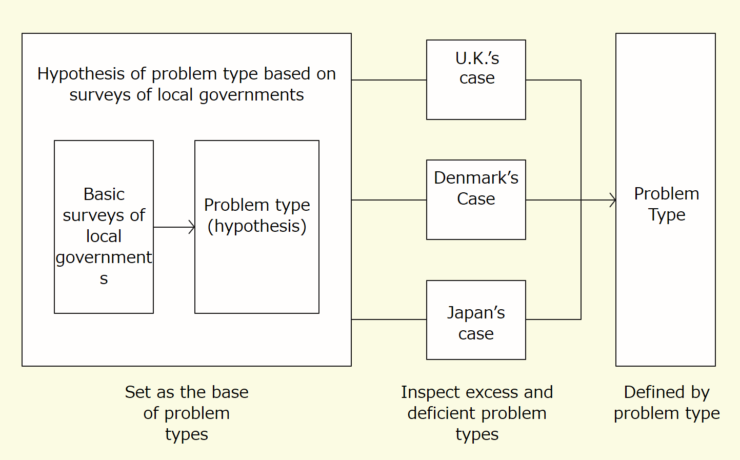
Through the process depicted above, the types of problems related to the digital divide in administrative services can be categorized as follows:
I The lack of prerequisites concerning digital use due to poverty and disabilities
II Insufficient resources, including ICT infrastructure
III Inaccessibility to technology by persons with disabilities
IV Digital illiteracy and resistance to digital use
V Lack of interest/resistance to administrative processes.
By analyzing and organizing the types of problems confirmed through interviews with local governments, the following were achieved:
- Recognition of the problems associated with the digital divide by local governments (Chapter 2)
- Comprehension of the current situation regarding the digital divide by users (Chapter 3)
- Measures already implemented by local governments (Chapter 4)
After analyzing and organizing the above, measures recommended for local governments were derived (Figure 2).
Figure 2. Structure of this report
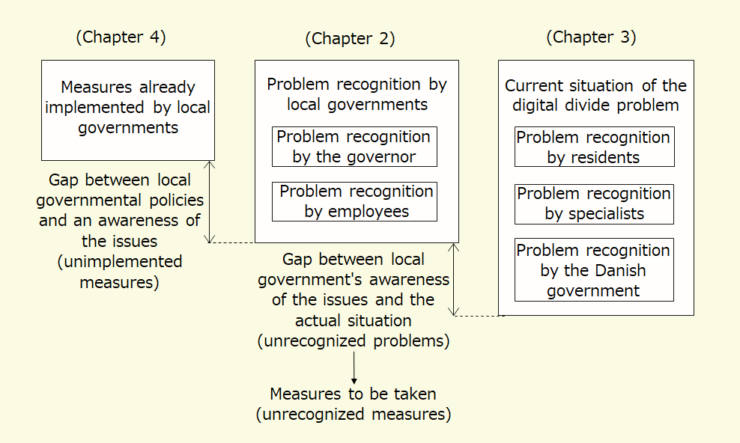
2. Local governments’ problem recognition
We analyzed the results of interviews and desktop surveys conducted with eight local governments and interviews conducted with mayors and employees of two cities (Nagaoka City, Niigata Prefecture, and Toyohashi City, Aichi Prefecture). As a result, we identified the tendencies and characteristics of the digital divide problem.
Table 1. to Table 3. are the digital divide issues seen in local governments:
Table 1. Details that suggest disparities: mayor of the city
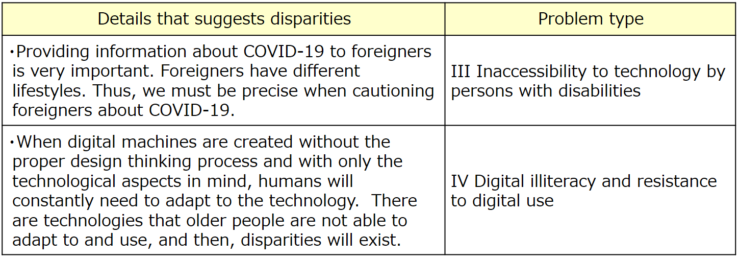
Table 2. Details that suggest disparities: city office employees
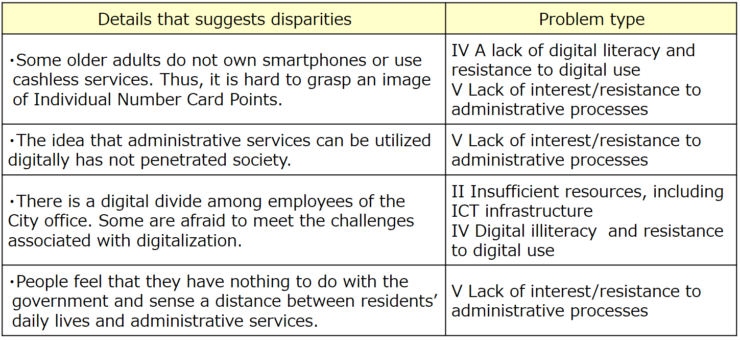
Table 3. Distribution of digital divide problems recognized by city offices according to problem type
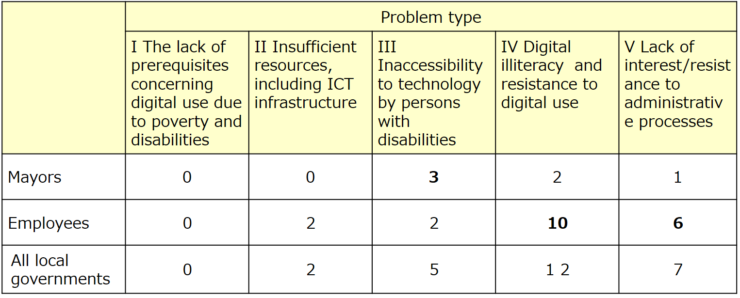
When disparities were categorized by problem type, it was observed that local governments emphasized “Inaccessibility to technology by persons with disabilities,” “Digital illiteracy and resistance to digital use,” and “lack of interest/resistance to administrative processes” as important digital divide problems.
3. Current situation of the digital divide problem
To understand the reality of the digital divide that residents are facing, we conducted interviews with residents from two cities (Nagaoka City, Toyohashi City), experts familiar with the digital divide, and organizations working to eliminate it overseas (Denmark’s Agency for Digitization)( Table 4.). A total of 23 residents of different demographics (e.g., older adults, college students, international students, foreigners) were interviewed so that the various problem types could be addressed.
Table 4. Awareness of issues by Denmark’s Agency for Digitization staff

Regarding problems felt by residents, “not being able to imagine the merits of using digital services” (“Digital illiteracy and resistance to digital use”), as well as “distress due to having to do all the paperwork on one’s own when not knowing the procedures,” were raised.
Table 5. shows the distribution of the digital divide problem according to problem type:
Table 5. Distribution of disparity issues recognized by residents

From the above, it can be observed that residents from all demographics faced disparities associated with “Lack of interest/resistance to administrative processes” (accounting for 13 of 22 disparity issues). In addition, there were differences between the disparities that the autonomous body recognized and those perceived by residents. It was confirmed that residents and specialists were aware of problems that local governments did not recognize. For example, concerns included “worry about doing administrative procedures that require no mistakes on the computer” (i.e., Lack of interest/resistance to administrative processes), as well as “input categories being insufficient when entering names into forms” (i.e., “ Inaccessibility to technology by persons with disabilities”).
4. Satisfaction with measures concerning the digital divide
Measures needed by local governments, with a view to recognize their problems, and bridge the gap between residents’ awareness of the problems and measures already implemented by local governments, have been organized in the table 6 to 8. We identified the following:
- Measures already implemented by targeted local governments
- Problems that were identified but for which relevant measures have not been implemented
- Measures for disparities that have not been identified by the local government(s)
Through this study, we confirmed that the administrative organizations needed to work toward closing the digital divide within its organization to close the digital divide among its residents. The measures that local governments should implement were organized separately for residents and staff.
Measures (b) and (c) are based on the knowledge obtained through the interviews and the hypotheses relative to specific cases. Practical measures as “concrete examples of approaches” are proposed.
Table 6. Measures already implemented by targeted local governments (a)
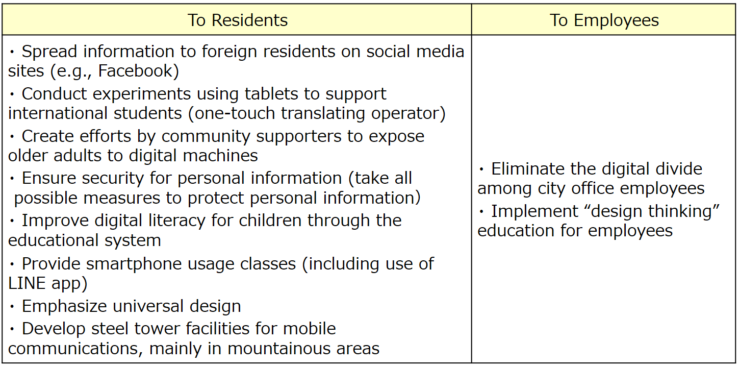
Table 7. Problems have been identified but measures have not been implemented (b)

Table 8. Measures for disparities that have not been identified by the local government (c)
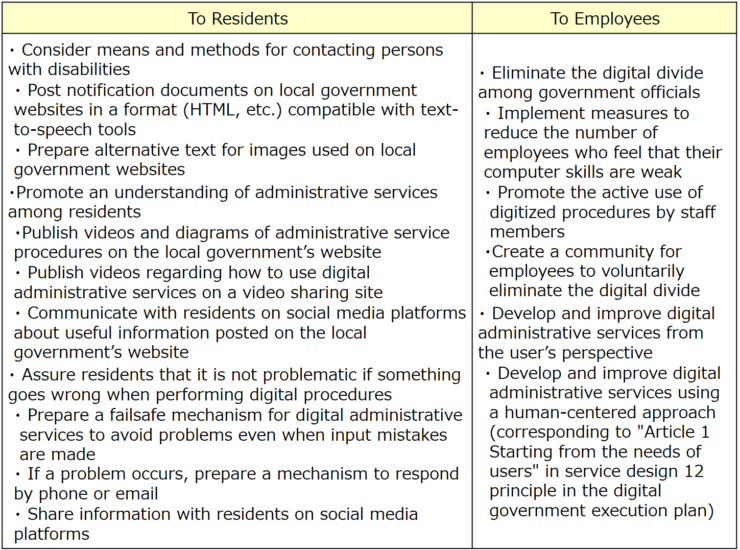
5. Conclusion
The following study findings were obtained regarding the digital divide in administrative services:
- There are considerable differences in the perception of digital divide issues depending on the city or town. In general, an awareness of issues increases with digitalization progress.
- There are various aspects of the digital disparities, and the measures to be taken differ for each problem.
- There are digital divide problems that are not recognized by government employees.
- The digital divide exists both within the community and in the administrative organization, and both must be addressed.
In addition, by clarifying problems related to the digital divide within local governments, by organizing the problems systematically, we were able to elucidate the measures needed to tackle each type.
At present, the digital divide in administrative services is not yet recognized as a real issue by many government officials and residents. However, as digitalization in administrative systems progresses, it is expected that the disparity between residents who can and cannot enjoy the benefits of these services will become more apparent. Many issues cannot be resolved overnight. For government agencies working on digitalization, it is important to consider the digital divide from a medium to long-term perspective toward policymaking.



Translated by Eiji Kano and Rinka Tonsho at AIS